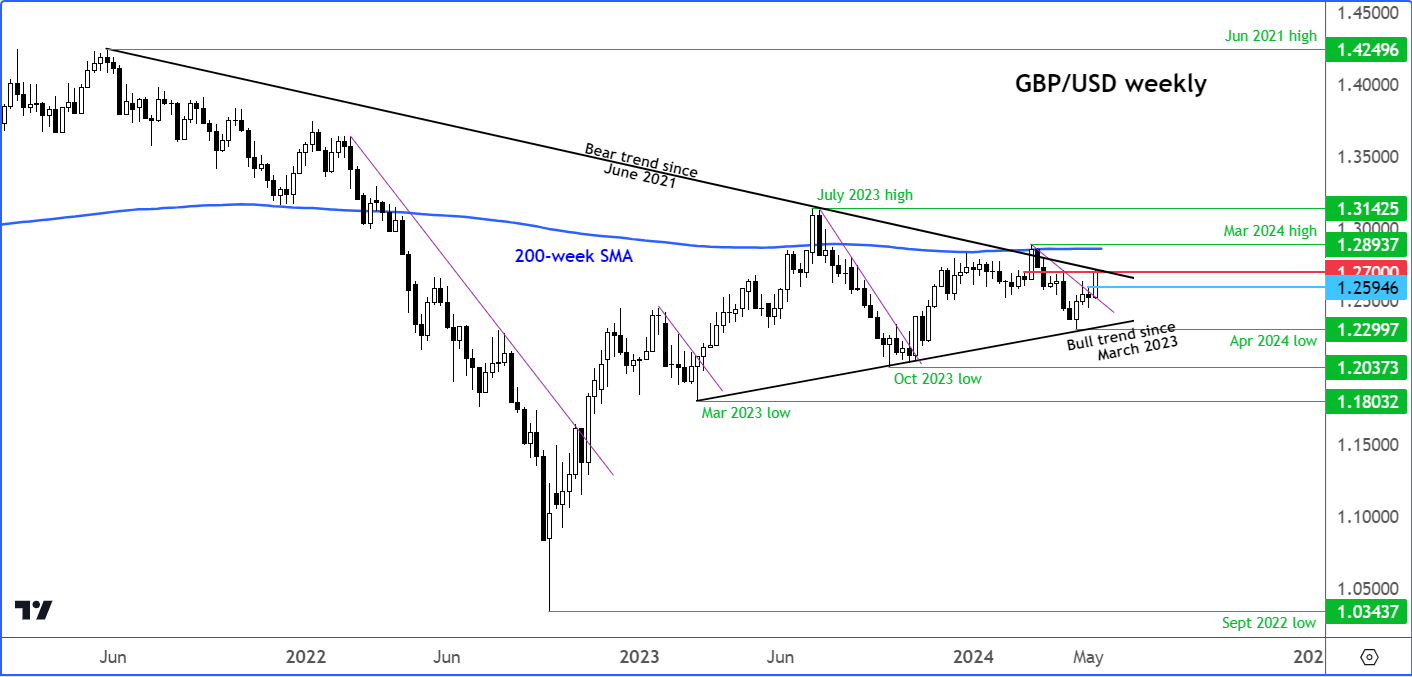
The GBP/USD was in consolidation mode in a quiet trade with most of Europe out on holiday and US macro calendar light. The cable posted a gain of 1.4% last week and looks like it is on the verge of staging a potential breakout above the 1.0700 resistance level. Last week’s gains were supported in part by stronger UK data and a weaker US dollar, thanks to softening macro pointers there. This week, we have UK inflation data and global PMI figures to trigger the next potential move. Our GBP/USD outlook remains bullish, mainly due to our bearish US dollar forecast. On the GBP side of the equation, the Bank of England is getting closer to cutting interest rates, although the market seems to be looking past this. Domestically, the focus this week is on UK inflation data, which is expected to cool, potentially cementing expectations that the central bank will cut rates in June.
GBP/USD outlook: US dollar finds mild support amid hawkish FedSpeak
Following last week’s USD selling, the dollar was catching a modest bid especially against the yen, which was the day’s weakest currency yet again. The Chinese yuan also fell, which weighed on the antipodean dollars. The EUR/USD drifted a bit lower, while the GBP/USD was flat. We have heard from several Fed officials arguing against premature rate cuts.
One trend that has emerged in recent weeks has been in US data, repeatedly disappointing expectations. With the economy evidently weakening in the US, it is becoming increasingly difficult to justify maintaining a bullish view on the dollar following the latter’s gains in the first 4 months of the year against a basket of foreign currencies. Last week alone, jobless claims, retail sales, industrial production, housing starts and building permits, as well as the Empire State Manufacturing Index, all came in weaker than expected, with CPI also a tad weaker. Earlier this month, the April non-farm jobs report, the latest ISM surveys and several other pointers, had all disappointed expectations too.
Therefore, it looks like the US economic growth is slowing, and if this trend continues then one could assume that inflation may ease, reducing the need to keep monetary policy tight for an extended period of time. The Fed’s tapering of its balance sheet runoff has been an additional bearish factor for the dollar.
Looking forward to this week and rest of May
This week, we have a few macro events to watch closely as they could impact the direction of the GBP/USD. These include UK CPI and retail sales, and global PMI data. From the US, the key data comes out on the final day of the month when core PCE is released, a week before the May jobs report comes out. Until then, the dollar’s volatility could be limited.
UK CPI seen cooling to 2.1%
UK economic data has shown surprising strength in recent weeks. Last week, the Average Earnings Index, including bonuses, exceeded expectations, rising by 5.7% in the three months to March compared to the previous year. This follows the previous week's above-forecast 0.6% growth in first-quarter GDP. The UK economy appears to be making significant strides toward recovery after several years of low output and high inflation. With the Consumer Price Index (CPI) cooling to 3.2% year-on-year in March, investors are interpreting these positive data surprises as a "Goldilocks" scenario—neither too hot nor too cold—propelling the UK 100 index to repeated all-time highs.
If the latest CPI reading, due on Wednesday, falls more than the expected 2.1%, it could further boost UK stocks. Additionally, UK retail sales data, scheduled for release on Friday, will provide further insight and potentially influence the GBP/USD direction. These indicators are crucial as they will help gauge whether the UK’s economic recovery is sustainable and how it might impact the currency market. Investors will be closely watching these releases to adjust their positions accordingly.
Global PMI data among week’s macro highlights
We have seen lots of evidence that the US recovery is starting to fade, just as growth in Europe and elsewhere have started to pick up. Thursday’s release of PMI data from Eurozone and UK’s services and manufacturing sectors will provide us with more insights about the potential recovery in Europe. Are we finally going to see a return to growth of manufacturing PMIs following nearly two years of sub-50 readings for German, French and UK manufacturers? Even if the pace of contraction slows more than expected, this would still be positive news given how poor the sector has performed in recent years.
GBP/USD outlook: Key levels to watch

Source: TradingView.com
The GBP/USD is aiming for a bullish breakout from converging trendlines on the long-term charts. The bulls are watching for a breakout above the resistance trend around the 1.2700 area. Will it succeed? Considering recent movements in other FX pairs and precious metals, a bullish breakout wouldn't be surprising, assuming this week’s incoming data and central bank speeches don’t change the ongoing US dollar weakening narrative drastically.
A decisive break above 1.2700 could lead to a rise towards the March high of 1.2893, with the psychologically significant 1.300 level coming into focus thereafter.
On the downside, the high from a couple of weeks ago, which marked the breakout point last week, stands at 1.2595. This level is the most critical support to monitor across all time frames.
-- Written by Fawad Razaqzada, Market Analyst
Follow Fawad on Twitter @Trader_F_R
How to trade with City Index
You can trade with City Index by following these four easy steps:
-
Open an account, or log in if you’re already a customer
• Open an account in the UK
• Open an account in Australia
• Open an account in Singapore
- Search for the company you want to trade in our award-winning platform
- Choose your position and size, and your stop and limit levels
- Place the trade












